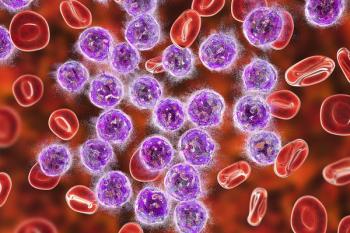
Oncology NEWS International
- Oncology NEWS International Vol 13 No 4
- Volume 13
- Issue 4
Second-Line Imatinib Produces CCRs in CML Patients
SAN DIEGO-In the IRIS study, newly diagnosed chronic myelogenous leukemia (CML) patients who crossed over from interferon (IFN)-alfa plus cytarabine (ara-C) to imatinib mesylate (Gleevec) and achieved a complete cytogenetic response (CCR = elimination of Ph+ cells), had reductions in bcr-abl similar to those on first-line imatinib, according to a presentation at the 45th Annual Meeting of the American Society of Hematology (ASH abstract 635). Their probability of achieving a CCR, is somewhat diminished, however, compared with those treated with first-line imatinib, said Jerald P. Radich, MD, Fred Hutchinson Cancer Research Center, Seattle.
SAN DIEGOIn the IRIS study, newly diagnosed chronic myelogenous leukemia (CML) patients who crossed over from interferon (IFN)-alfa plus cytarabine (ara-C) to imatinib mesylate (Gleevec) and achieved a complete cytogenetic response (CCR = elimination of Ph+ cells), had reductions in bcr-abl similar to those on first-line imatinib, according to a presentation at the 45th Annual Meeting of the American Society of Hematology (ASH abstract 635). Their probability of achieving a CCR, is somewhat diminished, however, compared with those treated with first-line imatinib, said Jerald P. Radich, MD, Fred Hutchinson Cancer Research Center, Seattle.
In IRIS (International Randomized Trial of Interferon/ara-C vs STI571), 1,106 CML patients had received imatinib 400 mg or IFN/ara-C. About 62% of IFN patients, for various reasons (eg, loss or failure of response, increasing WBC, intolerance), crossed over to imatinib (compared with 2% of imatinib patients crossing over to IFN).
For the IRIS Q-PCR (quantitative polymerase chain reaction) study, pre-study samples and samples collected every 3 months after CCRs were achieved were analyzed to determine a bcr-abl log reduction for 370 first-line imatinib patients (1,156 samples) and 112 second-line cross-over patients (199 samples).
First-Line Patients
In previously published results (N Engl J Med 349:1421-1430, 2003), an estimated 39% of imatinib and 2% of IFN patients achieved a major molecular response (3 log or more bcr-abl reduction) after 12 months of treatment. Among those patients with 3 log or more reductions, progression-free survival (PFS) was 100% at 24 months. For those with CCRs but less than 3 log reductions, PFS was 95%. In patients without CCR, PFS was 85%.
Dr. Radich stated that further follow-up has shown that bcr-abl log reductions have been at least maintained, and may be improved in first-line imatinib patients, with about 3.5 bcr-abl log reductions out to about 24 months. While at 3 months, about 75% had not achieved CCR, at 24 months only 24% had not achieved CCR; 68% achieved CCR at 12 months (see Table).
Progression-free survival was 100% at both 3 and 12 months in those with 3 log or more bcr-abl reductions; 98% and 95%, respectively, at those times with less than 3 log reductions; and 86% and 85% in patients without CCR. For these same groups, estimated PFS at 30 months was 100%, 93%, and 81%, respectively. Looking at CCR status at 3 months, Dr. Radich said that estimated 30-month PFS for these groups was 100%, 96%, and 85%, respectively. "You can start teasing apart what’s going to happen in the next 2 years based on CCRs," he added.
Cross-over Patients
Turning to cross-over patients, Dr. Radich observed the same trend as found in first-line patients, starting with about 2.8 log reductions in bcr-abl and plateauing at around 3.5 log reductions at around 15 months, but noted that fewer achieved CCR in second-line treatment. At 3 months, 83% had not achieved CCR, and at 12 months 49% had not (43% at 18 months) (see Table).
"With second-line imatinib therapy, fewer people achieve complete cytogenetic responses, but if they do have a molecular response, it is just as good as with front-line therapy," Dr. Radich said.
Dr. Radich concluded, "After 24 months, an estimated 55% of imatinib patients achieve 3 log or more reductions, which predict progression-free survival. Cross-over patients to imatinib who achieve CCR have bcr-abl reductions similar to first-line imatinib patients."
Dr. Radich had pointed out at the outset of his presentation, "the theme here is the power of monitoring in setting a course of how you can best treat patients via imatinib or alternatives. We want to emphasize the need to monitor cytogenetic data. . . . From there, you can start tailoring therapy based on response."
Articles in this issue
over 21 years ago
Anastrozole Advantage Greatest in ER+/PR- Pts: ATACover 21 years ago
Tam Not Linked to High-Risk Endometrial Caover 21 years ago
No Detriments From Lumpectomy/RT in BRCA 1/2 CarriersNewsletter
Stay up to date on recent advances in the multidisciplinary approach to cancer.
































































































